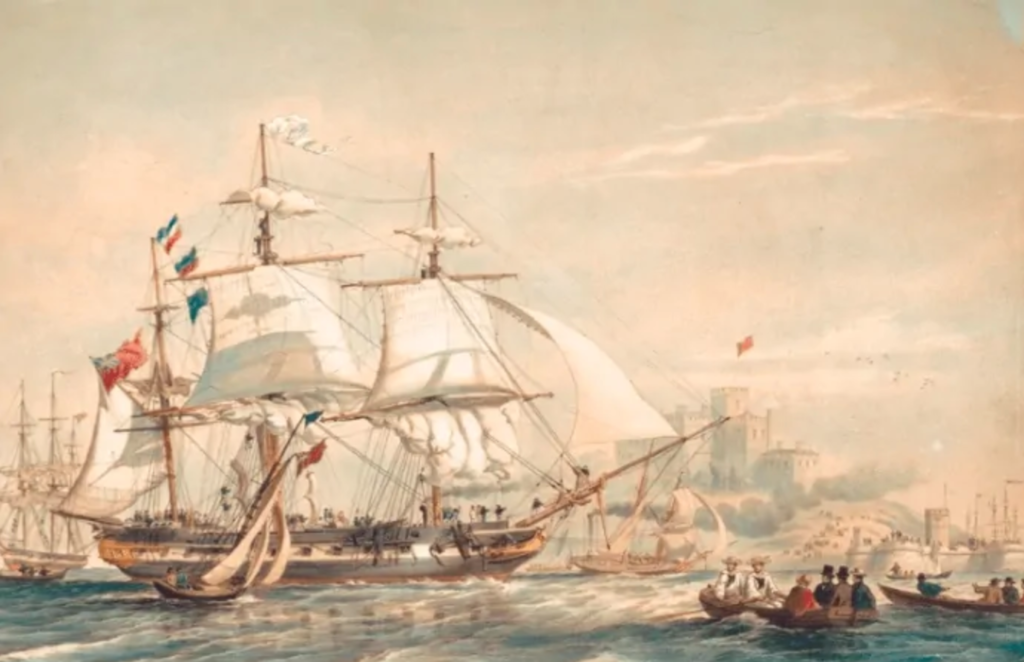The first confirmed Greeks to step foot on Australian soil were a group of seven sailors from Hydra who was transported to New South Wales to serve a sentence for piracy that was given to them by a British naval court.

They arrived in Australia on August 27, 1829. The sailors were convicted in Malta on charges of piracy and were eventually pardoned, but two decided to stay and settle.

In 1837 they all received Absolute Pardons and the Imperial Government agreed to cover the cost of their passage back to England so they could return to Greece.
Two of them Antonis Manolis and Gkikas Voulgaris remained in the colony while the other five men Georgios Vasilakis, Georgios Laritsos, Damianos Ninis, Nikolaos Papandreas and Konstantinos Strombolis returned to Greece.
Although some argue that there were a few more Greeks who arrived in Australia before this date, the first confirmed arrivals are these seven men that came aboard the “Hercules,” captained by Athenian, Antonis Manolis.
The next Greeks to establish new lives in Australia were also sailors who abandoned their English ships in Australian waters when they heard about the discovery of gold in the ‘new’ continent, as gold-seekers from around the world began pouring into the antipodean colonies.
These arrivals took place during the gold rushes of the 1850s and most of these new settlers from Greece saw their stay in the new country as temporary, intending to eventually return home and their families; thus very few women came to join them
By 1871, the population of Greek-born women in Victoria was still only 19, against 127 men.
As most often happens with migration, whether voluntary or involuntary, the original plans of return to the home country don’t always materialize. Once the gold rush waned, those who remained in Australia either became merchants or found employment in the food and retail industry, fruit fields, factories and mines. Joined in the aftermath by relatives and friends from the home country, their growth in numbers began to shape the emerging community of Greeks in Australia. They worked hard, and by the end of the 19th century the Greek communities of Sydney and Melbourne were well established
In May 1898, the foundation stone for the first Greek Orthodox Church in Australia was laid in Sydney and included Greek, Russian and Syrian worshippers and contributors. The Church was dedicated to the Holy Trinity.
In 1900, the foundation stone for the first exclusively Greek speaking Orthodox Church was laid in Melbourne. The church was dedicated to the Annunciation of the Theotokos.
In 1901, the Australian Census recorded 878 Australians that were born in Greece. Many Greek-Australians were owners or employees at shops and restaurants, while others were cane-cutters in Queensland, worked in mines, fields or factories.
The number of Greeks in Australia came to 2,000 in 1911 and the first Greek language weekly newspaper was published in 1913. In 1914, when WWI broke out, Greece remained neutral and the Australian government placed a special prohibition on the entry of Greeks to Australia. Even after Greece joined the war in 1917 on the side of the allied forces, the prohibition remained active until 1920.
The mid-war years saw a substantial surge in Greek immigration to Australia. In 1921, the number of Greeks in Australia was estimated at 3,654; in 1933 it rose to 8,337. This increase is believed to be the result of the Greek, Armenian, and Assyrian Genocide in Turkey. Another factor could be the 1923 population exchange between Greece and Turkey which left many Greeks homeless. A quota system however limited the number of non-British immigrants to Australia, Greeks included. Between 1925 and 1929, Greek immigration to Australia was capped at 100 people per month.
Following WWII, the Greek Government was struggling with post-war reconstruction and encouraged emigration (mainly 1950-1965), largely on account of swelling numbers of unemployed people.
During the same period, migrants would provide much-needed labour for Australia's reconstruction and industrialization as well as human capital for Australia's defence. Australia’s first Minister for Immigration, Arthur Calwell, promoted mass immigration with the slogan "populate or perish", which became a rallying cry to both quickly boost Australia’s population in the interests of economic and military security as well as overcome domestic resistance to non-British immigration.
By 1947, the number of Greek immigrants to Australia came to 12,000. Greek immigration to Australia continued to increase, particularly from the 1950s to the early 1970s when the Australian Government provided assisted passage to tens of thousands of Greeks. The most substantial flow occurred in the 1960s due to both economic (unemployment) and political (military dictatorship in Greece 1967-1974) reasons.
Some forty-two per cent of Greeks immigrating to Australia until the middle of the 20th century were from the islands of Kastellorizo, Kythira and Ithaca. The Kytherians mostly settled in Sydney, Kastellorizans in Perth, and Ithacans in Melbourne. These three cities still host the majority of Australian Greeks, who have expanded to other Australian cities, such as Adelaide, Australia's third-largest centre of Hellenism. Melbourne has the largest number of Australian Greeks, followed by Sydney.
The 2016 census recorded 397.431 people of Hellenic ancestry, of whom 93,740 were born in Greece. The Greek community of Australia is one of the largest Greek communities in the world.


